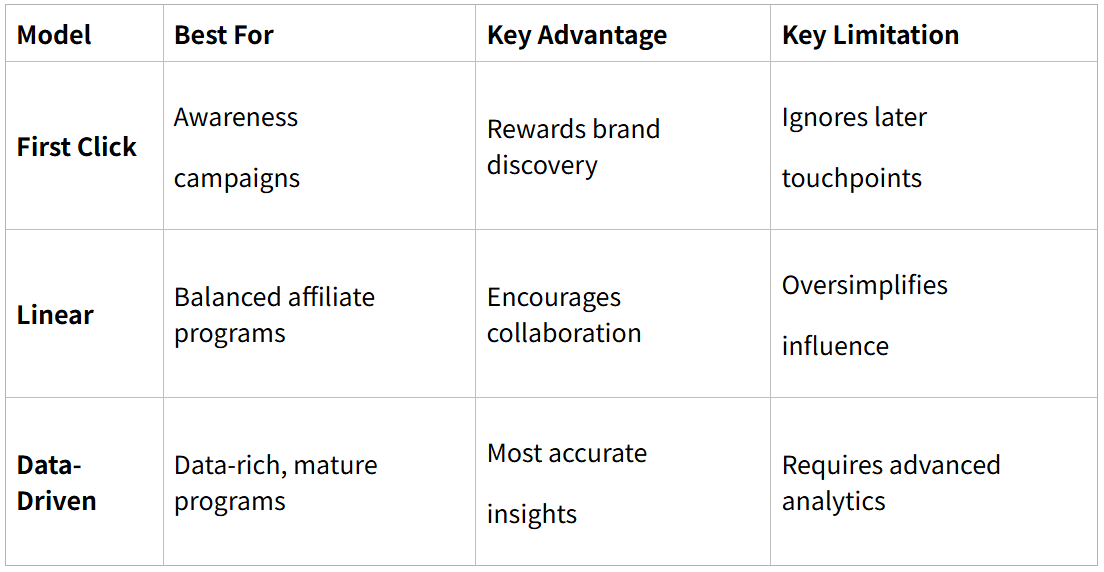Affiliate Attribution Models Explained: First Click, Linear, and Data-Driven Approaches Compared

In affiliate marketing, success isn’t just about driving traffic — it’s about knowing which touchpoints actually drive conversions. That’s where attribution models come in. These models determine how credit for a sale is assigned among different affiliates, helping advertisers optimize partnerships, allocate budgets, and maximize ROI.
Let’s break down the most common attribution models — First Click, Linear, and Data-Driven — and explore how each impacts your affiliate program strategy.
1. First Click Attribution: Rewarding the Discoverer
How it works:
Under this model, the first affiliate who brings a user to your site gets full credit for the conversion, regardless of how many other affiliates the user engages with later.
Pros:
●Great for recognizing top-of-funnel affiliates who introduce your brand to new audiences.
●Encourages content creators and influencers to focus on discovery and brand awareness.
Cons:
●May overlook the value of affiliates who nurture leads or close the deal later in the journey.
●Can discourage affiliates that specialize in lower-funnel activities like coupon or cashback promotions.
When to use it:
If your campaign goals are focused on brand exposure, awareness, and customer acquisition, the First Click model aligns perfectly.
2. Linear Attribution: Equal Credit for Every Touchpoint
How it works:
Linear attribution divides credit equally among all affiliates that interacted with a customer before conversion. For example, if three affiliates were involved, each receives one-third of the credit.
Pros:
●Promotes collaboration among affiliates rather than competition.
●Provides a balanced view of your conversion funnel.
●Rewards partners that contribute at different stages of the customer journey.
Cons:
●Lacks precision — not all touchpoints are equally influential.
●Can dilute rewards for affiliates that had a major impact on conversion.
When to use it:
If your affiliate strategy involves multiple partners playing distinct roles in awareness, engagement, and conversion, Linear attribution helps ensure everyone gets fair recognition.
3. Data-Driven Attribution: Letting the Numbers Decide
How it works:
Unlike rule-based models, data-driven attribution uses algorithms and historical data to determine how much credit each touchpoint truly deserves. It considers factors such as the number of interactions, time between clicks, and the affiliate’s influence on conversion likelihood.
Pros:
●Highly accurate and adaptable.
●Reflects real customer behavior rather than assumptions.
●Helps advertisers identify high-performing affiliates with greater precision.
Cons:
●Requires significant data volume and advanced analytics.
●More complex to implement and interpret.
When to use it:
For mature affiliate programs with large datasets, data-driven attribution delivers the most actionable insights — ideal for brands ready to optimize performance and scale intelligently.
Choosing the Right Model for Your Program

There’s no one-size-fits-all solution. The best attribution model depends on your marketing goals, affiliate mix, and available data. Many advertisers even adopt hybrid models, combining rule-based and data-driven elements to capture the full customer journey.
Here’s a quick summary:

Why Attribution Matters
Effective attribution doesn’t just tell you who drove a sale — it helps you refine your affiliate mix, negotiate better commission structures, and build stronger partnerships. By understanding how each affiliate contributes to the customer journey, advertisers can reward performance more fairly, boost campaign ROI, and drive sustainable growth across their affiliate programs.
Final Thoughts
Affiliate attribution is no longer a nice-to-have — it’s essential for success. Whether you’re optimizing awareness campaigns with a First Click model, balancing collaboration through Linear attribution, or unlocking precision with Data-Driven models, understanding how credit is assigned empowers you to make smarter, data-backed decisions.
Affiliate marketing thrives on transparency and insight — and the right attribution model can make all the difference.
Sources:
●Google Analytics Help: About Attribution Models
●Partnerize Blog: The Importance of Attribution in Affiliate Marketing
●Impact.com: Choosing the Right Attribution Model for Your Affiliate Program
CJ Affiliate: Attribution Models Explained





